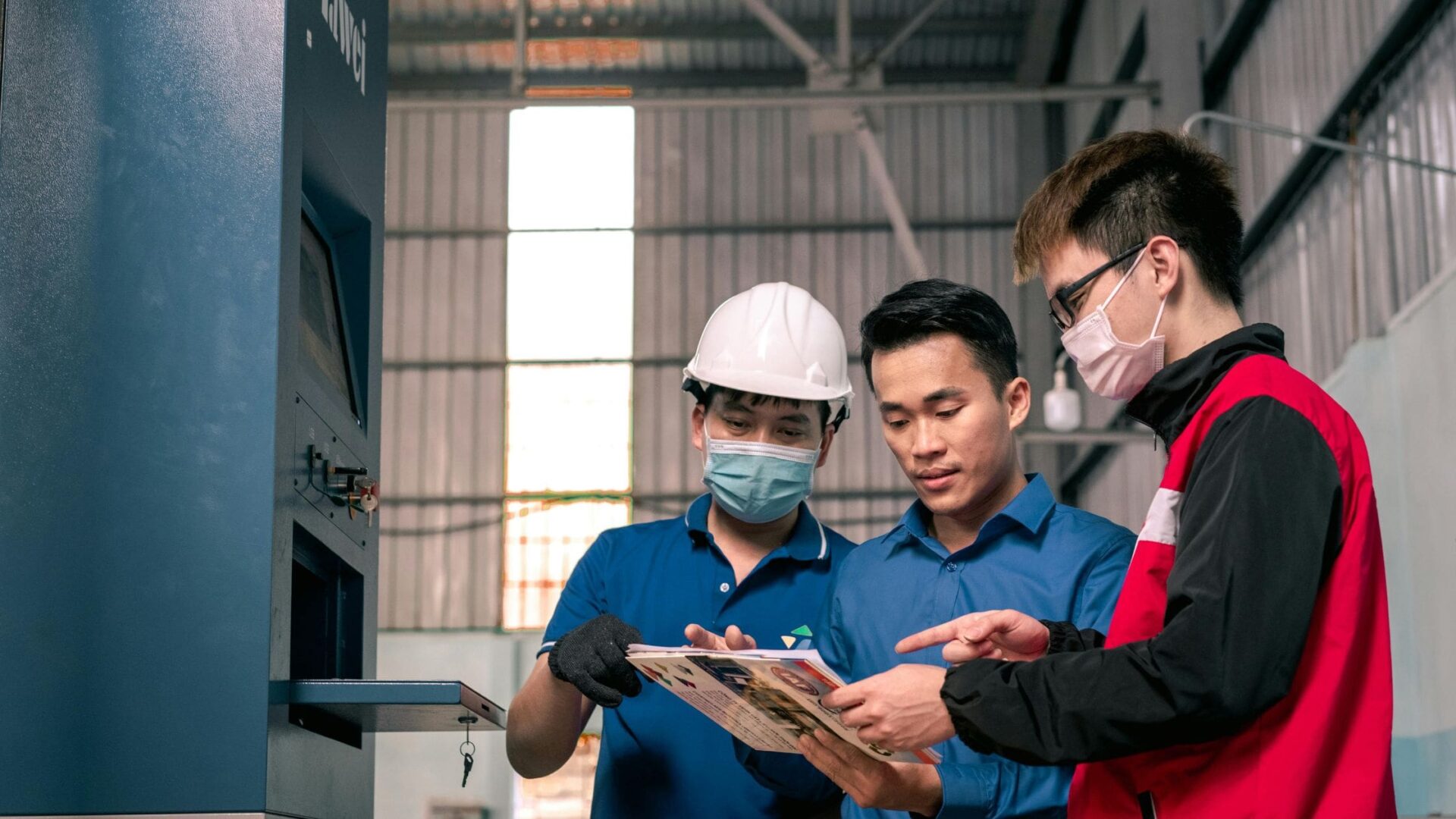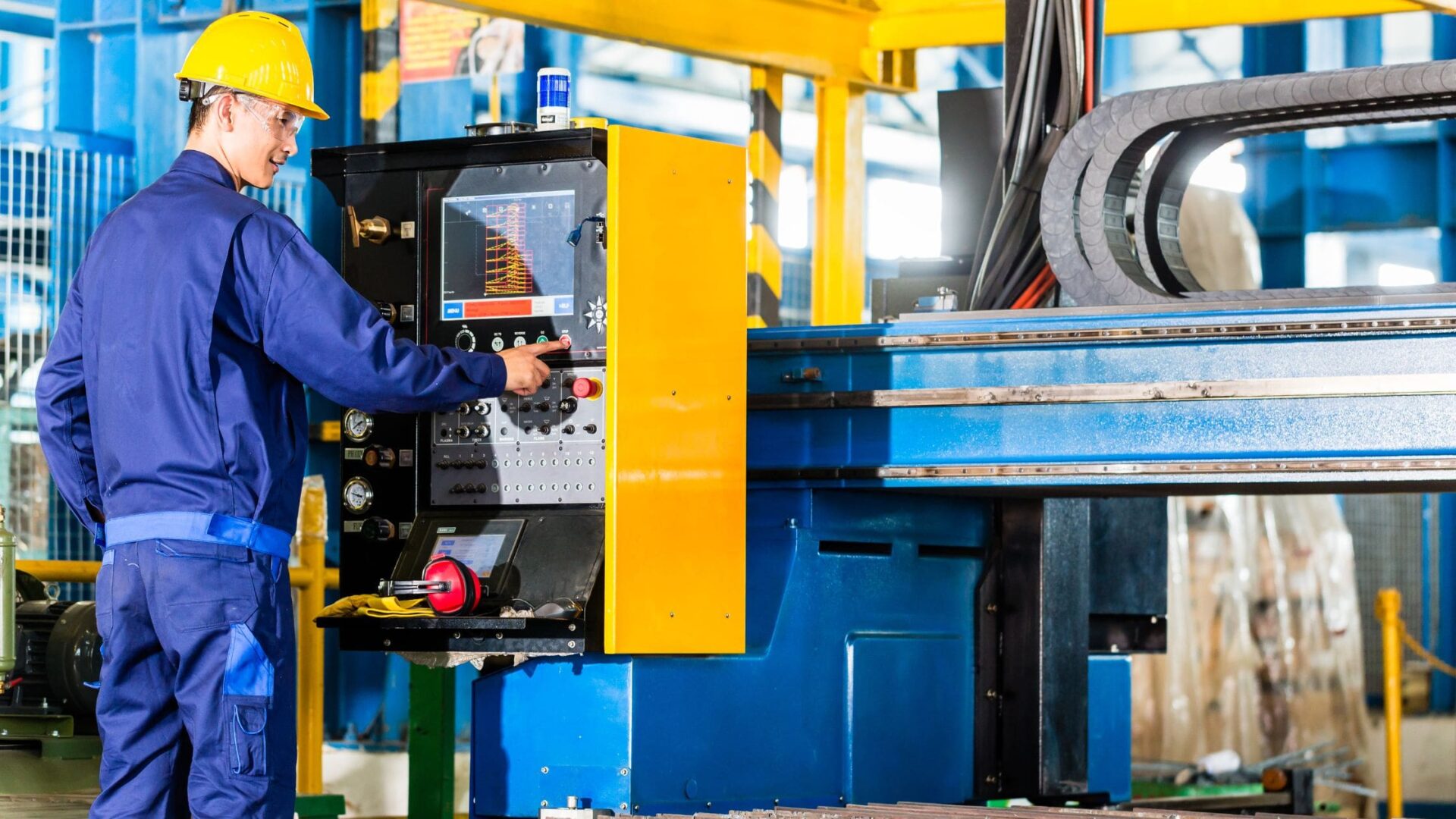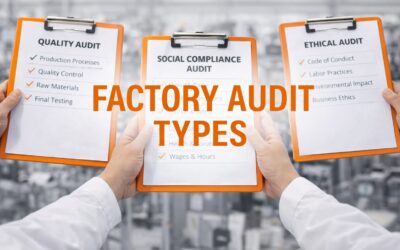When you run a manufacturing operation, safety isn’t something you can afford to treat as an afterthought. You’re not just responsible for making high-quality products, you’re also responsible for the people behind the machines. That’s where safety audits come in. Think of them as a full-body checkup for your facility. They look at everything from equipment conditions to training sessions, helping you spot potential hazards before they become serious issues.
Today, safety audits aren’t just about passing inspections, they’ve become part of how successful factories run. Regular audits help you lower accident rates, reduce downtime, and even cut insurance costs. In fact, leading manufacturers now use audit results to measure internal safety performance just like they track output or efficiency. And with non-compliance carrying heavy fines and downtime costing thousands per minute, being proactive about safety isn’t just smart, it’s strategic.
Technology is changing the game, too. Plants using digital audit tools and real-time photo documentation have cut reporting time by 40%. Some have even slashed accident-related costs from $500,000 to $250,000. Audit checklists have helped cut incident rates in half. And when teams from engineering, operations, and HR work together, they’re catching more risks, and bringing more people into the safety culture.
In this article, we’ll focus on what a safety audit really involves, why it matters for your business, how to do it right, and how you can turn it into a tool for real, measurable improvement.
What is a Safety Audit in Manufacturing?
A safety audit in manufacturing is a systematic and documented evaluation of workplace conditions, procedures, equipment, and training practices. Its purpose is to assess whether the company’s safety and health protocols align with internal policies and external regulations. Unlike routine safety inspections, which focus on surface-level issues, audits offer a more comprehensive review of the organization’s safety systems and identify potential weaknesses that day-to-day checks might miss.
The safety audit process generally follows a structured cycle. This includes defining the audit scope, conducting pre-audit data collection, performing on-site verification, analyzing findings, and implementing corrective actions. Each phase helps verify the effectiveness of safety procedures and strengthens compliance with safety regulations.
Manufacturers often initiate audits under specific conditions, such as the arrival of new management, expansion to multi-site operations, implementation of complex machinery, or in response to workplace incidents. These triggers highlight the need to evaluate current safety programs and ensure proper safety protocols are in place.
In many cases, companies bring in third-party safety auditors to minimize bias. External teams provide a neutral view of audit results and are increasingly requested by shareholders for verification. Typical audit teams include three to five trained members from departments like operations, engineering, and HR to ensure cross-functional input and a full-picture evaluation of workplace safety.
Why Safety Audits Matter in Manufacturing?
Safety audits are one of the most effective tools you can use to protect your workforce, improve operational efficiency, and reduce the financial risks tied to workplace accidents. By evaluating your safety program in a structured and measurable way, you gain insights into whether your current safety practices meet regulatory requirements and real-world demands. These audits help identify potential hazards that may not be obvious in daily operations and ensure that your safety management systems are aligned with current standards.
Here’s why regular safety audits play a critical role in maintaining your organization’s safety and performance:
Protect capital assets by detecting mechanical wear, poor guarding, and maintenance gaps before failures occur.
Reduce liability through documented compliance with safety regulations, limiting exposure to penalties and legal claims.
Boost workplace safety culture; employees who see issues addressed report 15% higher engagement and fewer incidents.
Cut insurance costs by lowering the rate of compensation claims and qualifying for 10–25% premium reductions.
Improve uptime; audited sites experienced a 35% drop in safety-related production stoppages.
Strengthen recruitment; publicized audit results led to a 12% rise in job applicant interest.
Ensure compliance with OSHA, ISO 45001, and local safety and health codes, which is essential for export-ready facilities.
How Do Safety Audits Impact Manufacturing Operations?
When you correct safety hazards, your facility becomes more organized, your teams work more efficiently, and your overall productivity improves. For example, resolving audit findings often results in clearer traffic lanes, better tool placement, and enhanced workflows. These improvements reduce defects, lower changeover times, and streamline business operations.
The impact on morale is just as real. Facilities that resolved critical safety concerns after an audit reported a 12% drop in voluntary turnover, signaling higher satisfaction and confidence in leadership. The post audit phase also brings financial improvements. Structured programs have helped plants reduce cost-of-accidents from $450,000 to $200,000 within two years.
Digital safety audits add even more value. Tracking audit actions digitally shortened closure timelines from 30 days to 18. Predictive models based on audit data were able to identify 70% of high-risk hazards up to two weeks before incidents occurred.
How Do Safety Audits Benefit Businesses?
If you’re sourcing products from a manufacturing partner, safety audits offer more than reassurance, they give you measurable insights into whether that facility can meet your brand’s standards. In today’s global supply chains, safety and health concerns are tied directly to trust, reliability, and long-term value. That’s why most businesses include a safety audit as a key part of a broader factory audit.
Factory audits typically cover multiple areas: quality management, social compliance, environmental sustainability, and operational capacity. But safety audits play a unique role in this evaluation. By reviewing safety protocols, accident records, training programs, and equipment conditions, you can identify potential hazards before they disrupt your business operations.
A strong safety audit process helps you:
Avoid production disruptions caused by unsafe practices or non-compliance with regulations.
Reduce the risk of liability by verifying that the supplier adheres to industry standards and proper safety practices.
Shorten onboarding time; third-party safety-audit reports cut qualification timelines by up to 30%.
Benchmark performance across multi-site suppliers using integrated audit data.
Lower your exposure to supply chain failures and reputational harm.
Improve customer perception, brands that share supplier audit results see a 3-point gain in customer-trust scores.
Reduce delivery issues; suppliers with safety accreditation report 20% fewer missed deadlines.
How Do Safety Audits Differ from Safety Inspections?
A safety audit is a system-level review focused on evaluating your organization’s safety management systems. It looks at documentation, training logs, safety performance metrics, and the broader effectiveness of safety policies. In contrast, a safety inspection is task-oriented, it targets immediate workplace hazards such as exposed wiring, blocked exits, or faulty personal protective equipment.
Inspections happen more frequently, often daily or weekly, and are usually led by internal safety officers. They help ensure that proper safety measures are being followed on the shop floor. Audits, on the other hand, occur quarterly or annually and involve reviewing the audit scope, conducting the audit through on-site verification, analyzing audit data, and reporting long-term trends. The outcome is often a risk-rated action plan that supports continuous improvement.
Here’s how they complement each other:
Inspections catch visible hazards quickly, while audits verify deeper compliance with safety regulations and industry standards.
Audits identify patterns behind workplace incidents by reviewing safety procedures and past audit findings.
Inspections result in immediate fixes; audits result in long-term corrective actions and updated safety plans.
Many manufacturers rotate third-party auditors for audits to ensure unbiased results.
What are the Core Elements of a Manufacturing Safety Audit?
A complete safety audit systematically evaluates physical, chemical, biological, and ergonomic risks across the facility. Each of these categories demands direct observations and sample-based assessments to identify potential hazards and verify adherence to safety standards.
Emergency response plans are also a core focus. You should expect the audit team to test alarms, evaluate evacuation routes, and review contractor-control procedures that affect workplace safety. These steps ensure that your facility is prepared for real-world emergency situations, not just routine operations.
A full audit also includes reviewing incident investigation quality, assessing whether root causes were addressed, and analyzing trends from the past 12 months. Comprehensive checklists examine equipment safety, lighting adequacy, air quality, and the visibility of safety signage. These elements reveal how well the work environment supports health and safety.
Management involvement is another key element. Evidence of safety plan funding, participation in walkthroughs, and prompt execution of corrective actions shows leadership accountability. On the employee side, audit teams look for active participation through toolbox talks, near-miss reporting, and feedback loops, indicators that your safety culture is both proactive and maturing.
Safety Audit Checklist
Your safety audit checklist should cover a range of safety procedures and workplace conditions that reflect both industry standards and site-specific risks. This tool helps the audit team stay consistent while assessing the effectiveness of safety across departments.
Checklists typically include items like personal protective equipment usage, machine condition assessments, and fire safety readiness. Specific line items might flag issues such as blocked fire exits, exposed electrical wiring, and missing lock-out/tag-out signage. Auditors also examine ventilation systems for airflow effectiveness and check that flooring surfaces offer proper slip resistance.
Lighting is another important factor, assembly areas should meet a minimum of 300 lux. Emergency equipment, including extinguishers and first-aid kits, must have a clear one-meter aisle surrounding them at all times. These checks help identify potential hazards before they escalate into injuries or compliance issues.
Digital checklists with mandatory photo documentation are now standard in many manufacturing sites. These tools reduce oversight errors by 25% and enhance accountability during the audit process.
Hazard Identification and Risk Controls
During the audit process, you’ll review operational areas for risks related to mechanical equipment, chemical exposure, repetitive motion, and unsafe work practices. The goal is not just to detect these hazards, but to understand their causes and prioritize how they should be addressed within your safety management system.
Auditors use a hierarchy of controls to evaluate the effectiveness of safety responses. The preferred sequence begins with elimination, then moves to substitution, engineering controls, administrative practices, and finally personal protective equipment. Every finding is then ranked in a 5×5 risk matrix based on likelihood and severity, with specific owners assigned and deadlines established for corrective actions.
Audit teams frequently uncover recurring issues such as improper PPE use, missing machine guards, and untreated slip hazards, logging 150+ combined cases in a typical six-month window. Some manufacturers are now applying predictive scoring algorithms to audit data, which has proven to flag over 70% of high-risk incidents before they occur.
Inspection of Safety Equipment
Auditing safety equipment is an essential part of verifying your facility’s readiness to prevent, manage, and respond to workplace incidents. This step ensures that critical systems like fire suppression tools, alarms, guards, and harnesses are fully functional and compliant with health and safety standards. A well-executed equipment review not only protects workers but also reinforces confidence in your organization’s safety protocols.
During the audit, your team should evaluate whether monthly service records are current for all fire extinguishers and if weekly checks have been completed for machine guarding systems. Emergency alarms should meet the minimum 85-decibel threshold at operator stations to ensure audibility during emergencies. For fall protection, all harnesses must have inspection tags updated at least every six months.
These inspections help you identify potential safety hazards tied to aging or neglected tools. When paired with digital audit platforms, photos and notes logged in real time improve audit data accuracy and create traceable documentation.
Employee Involvement
Employee involvement is one of the most accurate indicators of whether a safety audit will lead to meaningful change. If you want to strengthen your organization’s safety culture, start by ensuring that workers are part of the process. During the audit, it’s recommended that at least 10% of the workforce on each shift be interviewed. These employee interviews help uncover undocumented near-misses, procedural gaps, or overlooked hazards that may not appear in written records.
Observing employees at work also offers insight into how safety procedures are followed in real conditions. Peer-led observation programs have been shown to increase hazard reporting by 35%, highlighting how involvement improves both awareness and accountability.
Facilities that survey employees during the pre-audit phase typically generate 20% more actionable ideas compared to those that rely only on management input. When workers are engaged, the audit process becomes more than a compliance check—it becomes a feedback loop that drives continuous improvement in workplace safety and health.
Management Commitment and Participation
The success of any safety audit depends heavily on the level of engagement from leadership. If managers treat the audit as a checklist task, the organization’s safety performance is unlikely to improve. But when leaders actively support the process, by funding safety initiatives, participating in walkthroughs, and following up on corrective actions, they send a clear message that worker safety is a company priority.
A strong audit process includes formal steps to reinforce accountability. One best practice is to require a signed close-out of high-priority corrective actions by a senior manager within 30 days. This confirms that safety measures are being implemented and not just discussed.
Data also supports the importance of executive involvement. When leadership attends quarterly safety-review meetings, findings close 22% faster. In mature safety management systems, budgets for corrective actions typically account for at least 0.5% of the annual plant operating cost.
Training and Education Programs
Effective safety audits don’t end with inspection, they begin by asking what your employees actually know. A strong training program lays the groundwork for preventing workplace injuries, enforcing safety protocols, and building a culture of compliance with safety regulations. You need to ensure that onboarding includes proper safety orientation, job-specific refresher courses, and personal protective equipment fit-testing before any work begins. This foundation allows employees to understand not only what safety procedures exist, but why they matter in your unique work environment.
Training programs should go beyond passive checklists. A well-structured safety plan includes annual participation in emergency drills and ongoing access to digital learning platforms that track completion, send automated reminders, and support updates across departments. Plants that align post audit findings with targeted micro-learning modules report a 30% drop in repeat safety issues, clear evidence of improved workplace safety through knowledge.
To sustain the effectiveness of safety audits, you must treat safety training as a continuous process, not a one-time activity. These programs serve as both a pre audit preparation tool and a long-term investment in your workforce’s well being.
How to Conduct a Safety Audit in a Manufacturing Facility?
To support operational efficiency and reduce workplace risks, your audit team should initiate planning at least four weeks ahead.
This early phase includes issuing an official audit notice, defining the scope of the audit in writing, and collecting 12 months of workplace incident reports, near-miss logs, and accident reports for analysis. On audit day, assign team members to specific functions, two to conduct safety sampling, two to interview employees, and one to review documentation. Each person plays a vital role in identifying potential hazards, inspecting safety procedures, and verifying adherence to health standards.
Make sure at least one job change-over is observed per manufacturing line, and use photographic records to document non compliance. This strengthens both the audit report and follow-up action plans. Once the audit is complete, schedule a debrief within 24 hours to align stakeholders on initial findings and corrective actions.
Pre-Audit Preparation
Before conducting safety audits, it’s important that you invest time in preparing your audit team and facility. Start by notifying your workforce at least two weeks in advance. This not only sets expectations but also fosters employee involvement, critical for gathering accurate data on potential hazards and safety concerns.
During the pre audit phase, gather at least one full year of safety training records, incident logs, and safety inspection reports. Review any unresolved corrective actions to ensure that previous findings haven’t been neglected. This helps you understand the root causes of past workplace accidents and frame the scope of the audit accordingly.
Digital project management tools are valuable here. You can assign pre-audit responsibilities, track readiness progress, and coordinate schedules across departments.
Conducting the Audit
Once the pre-audit groundwork is done, you move into the fieldwork. During this stage, your audit team should conduct safety inspections across departments, observe daily operations, and identify potential hazards in real time. Be sure to photograph deficiencies for documentation and track safety procedures during at least one job change-over per production line. These observations provide practical insights into safety and health conditions under normal operating pressure.
Interview employees across different roles, from floor operators to line supervisors, to gather varied perspectives on workplace safety. These conversations often reveal unreported issues and inconsistencies in safety protocols.
Use calibrated tools to measure ambient noise and lighting levels to ensure your facility meets OSHA requirements and ergonomic guidelines. A thorough audit process balances compliance verification with identifying root causes of workplace risks.
Reviewing and Evaluating Data
After conducting the audit, it’s time to turn raw data into meaningful insights. Begin by sorting audit findings into categories, personal protective equipment failures, training gaps, or procedural non compliance. Then apply Pareto charts to identify the top 20% of safety issues contributing to 80% of your risk exposure. This approach focuses attention on the most critical hazards impacting employee safety.
Trend lines help assess the effectiveness of safety measures over time. Compare new audit data against previous safety inspection results to determine whether past corrective actions are driving sustained improvement. You’ll quickly see if workplace incidents are declining, or shifting location.
Leverage predictive analytics tools to flag irregularities in incident patterns or recurring workplace injuries. These tools support proactive decisions before risks escalate into safety violations.
Corrective and Preventive Actions
To improve workplace safety, assign SMART corrective actions that are specific, measurable, achievable, relevant, and time-bound. These actions should be ranked by urgency: 48-hour fixes for immediate risks, 30-day goals for moderate issues, and 90-day plans for systemic improvements in your safety program.
Using automated task reminders can reduce overdue actions by up to 40%. This ensures compliance with safety regulations without adding burden to daily operations. Action-plan dashboards improve visibility and keep the workforce aligned.
Corrective actions aren’t just checkboxes. They are the link between identifying potential hazards and ensuring long-term improvement.
Post-Audit Reporting and Follow-Up
Your audit process isn’t complete without clear, timely communication. Once the audit report is compiled, share it with all stakeholders, managers, supervisors, and frontline employees. A concise, diagram-rich summary increases engagement and reinforces transparency across the organization.
You should also schedule a follow-up verification audit within 60 days for any high-risk findings. This step confirms that corrective actions are not only implemented, but effective. Regular safety audits lose value without proper follow-up.
Reports should include data visualizations, safety audit checklists, and summaries of workplace incidents. These tools support decision-making and track continuous improvement.
What Does a Safety Audit Report Include?
When you finish conducting a safety audit, the next step is turning raw findings into a structured safety audit report. This document is the foundation for safety improvement and regulatory compliance. It typically begins with an executive summary that outlines key risks, audit scope, and general conclusions about the company’s safety and health performance. Right after that, you’ll find safety audit checklist scores that measure adherence to established safety protocols across departments.
The report then details findings, non-compliance areas, and workplace hazards identified during the audit process. Each issue is paired with corrective actions and closure timelines to drive accountability. Including a severity-probability risk matrix helps prioritize risks based on potential impact. Appendices should contain photographic evidence of safety concerns and site conditions observed during inspections.
You also want to include:
Cost-benefit estimates for major safety recommendations
A management sign-off section to confirm commitment
Diagrams that visualize trends and safety performance gaps
Who Is Responsible for Conducting Safety Audits?
Responsibility for conducting safety audits depends on your facility’s goals, risk profile, and available resources. Typically, the responsibility falls on either internal safety teams, third-party professionals, or official regulatory bodies. If you’re managing an in-house safety program, you’ll likely assign this task to internal auditors trained in safety management systems. These individuals understand the nuances of your work environment and can ensure compliance with safety regulations while protecting operational confidentiality.
However, many organizations also rely on third-party professionals—especially when impartiality is needed. External audits save internal time, provide unbiased perspectives, and often include full factory inspections beyond the pre audit scope. In fact, rotating external auditors every three years is considered best practice for maintaining audit quality and bringing in fresh insights on workplace safety.
Regardless of who leads the audit, one thing is non-negotiable: every audit team must include at least one certified safety professional or someone with equivalent expertise.
How to Prepare a Manufacturing Plant for a Safety Audit?
As someone responsible for operational efficiency and safety management, you want to identify potential hazards early, reduce non-compliance risks, and ensure documentation is audit-ready. The goal is simple: minimize disruptions while demonstrating your company’s safety protocols are not only in place but effective.
Start by reviewing your existing safety plan, inspection reports, and workplace safety policies. A mini internal audit, conducted two weeks in advance, gives you time to fix overlooked safety issues, especially common ones like expired emergency response plans or blocked exit paths. Prioritize the calibration status of safety equipment and ensure all certificates are current and accessible.
Don’t forget people. Brief your workforce on safety procedures and what to expect during the audit. Then, 24 hours before the audit, stage a final site review:
Inspect floor areas for trip hazards or equipment obstructions
Check personal protective equipment (PPE) availability and usage compliance
Verify that all safety training records and maintenance logs are up-to-date
Recheck areas flagged during the last post audit to confirm corrective actions were completed
What are the Key Benefits of Conducting Regular Safety Audits?
Safety audits play a vital role in improving workplace safety, reducing workplace accidents, and ensuring compliance with safety regulations. When done consistently, they enhance not only employee well-being but also business operations and long-term cost control.
There are nine key advantages:
Reduce workplace accidents by uncovering potential hazards before they escalate, helping you maintain a safer work environment
Improve compliance with health and safety standards and industry-specific safety regulations, reducing legal liabilities and potential fines
Minimize insurance premiums as insurers often provide up to 10% discounts for documented, effective safety audits and safety training programs
Enhance employee engagement by involving your workforce in safety initiatives and showing that their well-being is a company priority
Preserve equipment lifespan through timely maintenance identified during the audit process, avoiding costly equipment downtime
Strengthen brand reputation by aligning your organization with proper safety standards and transparent auditing techniques
Enable data-driven decisions by using audit data and trend analysis to guide safety-related investments and resources
Support emergency readiness by ensuring emergency response procedures are well-practiced and equipment is functioning correctly
Promote a positive safety culture across departments, increasing adherence to safety protocols and reducing resistance to safety procedures
What are the Best Practices for Effective Safety Audits?
Effective safety audits rely on a consistent, informed, and data-driven process. They’re not only about identifying workplace hazards but also about improving your company’s safety performance over time.
Start by aligning your audit process with your organization’s safety management system. Use digital platforms that offer centralized storage, automated reminders, and real-time audit data analysis. These tools streamline documentation, reduce errors, and ensure your safety procedures are followed properly. Make sure safety audit findings are accessible and reviewed during post audit debriefings.
Encourage employee involvement throughout the audit process. Recognize departments and individuals with zero repeat findings. This reinforces safe work practices and strengthens your company’s safety culture.
Regular feedback, consistent documentation, and visual dashboards help you track safety improvements and respond quickly to new safety concerns.
Establish Regular Audit Schedules
A critical part of maintaining workplace safety is creating and sticking to a regular safety audit schedule. Without frequency and consistency, even the most effective safety audits lose their value.
You should implement yearly comprehensive audits to assess your entire manufacturing plant. These audits offer a full picture of your safety program and identify potential hazards across departments. For high-risk areas, conduct semi-annual focus reviews to stay ahead of emerging issues.
In between, introduce weekly mini-audits in zones with frequent safety issues. These small-scale reviews catch over 60% of workplace hazards before they escalate into incidents. You can also use remote video spot checks, especially useful when site visits are limited. They improve visibility while keeping your workforce alert and engaged.
Customize Audit Checklists
If you’re using the same generic safety audit checklist across all departments, you’re likely missing the real issues. Customizing your checklist allows you to target hazards relevant to your manufacturing site’s specific conditions and tasks. This is especially important when you’re introducing new equipment or updating emergency response procedures.
You should revise audit checklist items at least quarterly. Doing so not only reflects current workplace conditions but also integrates recent incident data and any changes in safety policies. Plants that made these adjustments regularly saw a 15% reduction in repeat non-conformities, a strong sign of improved safety performance.
By tailoring checklists, you allow safety auditors to focus on high-risk zones and observe how your safety measures respond to real-world challenges.
Cross-Functional Collaboration
No single department can carry the full weight of conducting a safety audit. Involving multiple functions, like operations, EHS, maintenance, and even HR, ensures that you address both the technical and cultural aspects of workplace safety. Finance should also be involved to align any recommended safety improvements with available budgets.
When different departments work together during audits, the organization benefits from broader insights into potential hazards and safety concerns. This collaboration strengthens safety management systems and accelerates issue resolution. In fact, companies using cross-functional audit teams have been shown to close audit findings 20% faster.
You should aim to build audit teams with a mix of perspectives, this not only improves the accuracy of safety inspections but also increases employee involvement and accountability across departments.
Data Documentation and Secure Storage
The audit doesn’t end when the walkthrough is complete, it continues with how you manage your findings. Proper documentation ensures your safety audit data is not only available for post audit analysis, but also ready for compliance checks or emergency response planning.
Storing audit reports securely is just as important. Using encrypted cloud platforms with role-based access controls helps protect sensitive safety and health records while reducing paper waste. It also speeds up data retrieval during safety inspections, what once took hours can now take minutes.
Digital documentation supports more than just convenience. It enables you to track audit trends over time, measure the effectiveness of safety training programs, and quickly identify recurring safety issues.
How Often Should Safety Audits Be Performed?
For most facilities, conducting the audit at least once per year is the baseline standard. This ensures your company remains compliant with safety regulations and allows you to assess the effectiveness of safety measures across departments.
However, if you operate in a high-risk environment, such as a busy manufacturing plant, you may need to adjust that timeline. Performing regular safety audits every six months, or even quarterly, is recommended when dealing with hazardous equipment, multiple shifts, or a high volume of worker activity. In the case of major incidents or changes in processes, ad-hoc audits should follow immediately.
To reinforce audit results, many businesses also implement weekly mini-audits targeting top hazards. These quick safety checks can significantly reduce downtime and help identify potential hazards before they escalate. Re-auditing within two months of a serious finding is also a best practice to verify closure and prevent repeat occurrences.
How Long Does a Safety Audit Take to Complete?
A full-scope plant safety audit typically spans two to five working days, depending on the size of your site, the number of shifts, and how well your documentation is prepared. During this phase, auditors assess your safety protocols, examine workplace conditions, and conduct employee interviews to evaluate safety training effectiveness and identify potential hazards.
After the on-site portion is complete, drafting and reviewing the audit report typically adds another one to two weeks. This post audit phase is essential, it allows your team to analyze findings, confirm compliance with safety regulations, and prepare actionable recommendations that improve your organization’s safety culture.
Facilities using digital data entry tools often reduce audit times by up to a full day. Automating parts of the safety audit process, such as data collection and document storage, enhances operational efficiency while improving the reliability of audit results.
How Much Does a Safety Audit in a Factory Cost?
Most third-party safety audits for mid-size factories range from USD 5,000 to 15,000, depending on your location, the depth of the audit, and the audit scope. In China and other major Asian manufacturing countries, base rates tend to be lower, often starting around USD 3,000, though specialized audits involving high-risk processes or chemical handling push the total up significantly. Adding targeted hazard analysis or custom risk assessments can increase costs by 10–30%.
Key cost drivers include the credentials and experience of the safety auditors, how many shifts are observed, and whether your audit team is reviewing pre audit documentation or conducting extended employee interviews. Travel expenses also play a role, though remote or hybrid audits can reduce travel-related costs by up to 25%, especially for multi-site reviews.
Even with these costs, the return on investment is hard to ignore. A single serious workplace accident can result in over USD 120,000 in direct and indirect costs. Preventing just one such event could offset years of regular safety audits. Companies that consistently invest in workplace safety and health programs often report post audit reductions in accident-related costs of over USD 250,000 annually, along with improvements in employee safety, morale, and operational efficiency.
What Challenges Do Manufacturers Face in Safety Audits?
One of the biggest hurdles is complying with multiple layers of safety regulations across regions or countries. For companies operating internationally, differences in legal frameworks, health standards, and reporting requirements can place serious strain on internal audit teams and safety management systems.
Another ongoing issue is production scheduling. When manufacturing runs 24/7, it’s hard to find a window for a thorough audit without disrupting output. Night-shift work often goes unobserved, leading to incomplete data and gaps in the evaluation of safety procedures. A lack of visibility into off-peak operations can mask serious workplace hazards.
Root-cause analysis presents its own complications. In complex manufacturing plants, hazards often arise from system-level interactions. You might find that identifying potential hazards is easy, but linking them to specific departments, equipment, or actions becomes difficult when responsibilities overlap. These challenges impact the effectiveness of safety audits and limit your ability to apply meaningful corrective actions.
Inadequate Planning or Scheduling
If the pre audit phase doesn’t include clear communication about timing, scope, and documentation, the audit process will stall before it starts. You might have the right tools and team in place, but if no one’s ready with the records, training sessions, or safety protocols to review, the audit can become reactive instead of strategic.
An effective solution is to align your safety audit calendar with production lulls or scheduled shutdowns. This reduces operational disruption while giving your auditors full access to all departments. You should also communicate the audit scope to department managers at least four weeks in advance. That lead time allows teams to organize documents, prepare for employee interviews, and make sure physical spaces are ready for inspection.
Overlooking Subtle Hazards
Not all workplace hazards are obvious. Subtle ergonomic risks, like poor workstation layout or repetitive motion stress, might seem minor at first but often lead to long-term health and safety concerns. These overlooked areas contribute to nearly 30% of all recordable workplace injuries, especially in assembly-line and packaging roles.
If you’re conducting the audit without input from frontline employees, you risk missing warning signs entirely. Implementing near-miss reporting systems and encouraging open feedback during safety training programs can help identify these concerns before they escalate. In fact, facilities that introduced structured feedback training saw a 25% increase in detection of low-visibility hazards.
Resistance to Change or Feedback
Safety audits play a vital role in identifying potential hazards, but change only happens if the workforce is willing to act on the findings. One common barrier to effective safety is cultural pushback, when employees see safety measures as interference rather than protection. This resistance can slow down corrective actions or lead to incomplete adoption of updated safety procedures.
You can break this cycle by involving team members early. Joint safety committees give your employees a voice in decisions, while recognition programs reward proper safety behavior and boost morale. When plants shared audit results openly and explained the reasoning behind each action plan, resistance to improvements dropped by 15%.
What are the Legal and Regulatory Standards That Influence Safety Audits?
In the United States, OSHA forms the cornerstone of safety audits, setting detailed workplace safety requirements across industries. OSHA violations can lead to serious penalties, with willful or repeated infractions reaching over USD 16,000 per item. That adds up fast when systemic issues go unaddressed.
Globally, ISO 45001 serves as the primary framework for occupational safety and health. It guides the structure and scope of the audit process, helping you build an effective safety management system that reduces workplace incidents and promotes employee well-being. In the EU, CE marking and compliance with directives like 2009/104/EC require documented safety audits before market entry, especially for machinery and industrial equipment.
To harmonize overlapping standards, use unified safety audit checklists and map regulatory overlaps in your audit plan. This approach allows your audit team to streamline documentation while upholding local labor laws and international safety standards. It also reduces duplication and improves the effectiveness of safety procedures.
How Can Manufacturers Ensure Continuous Improvement After Safety Audits?
If you want to build a sustainable culture of safety, post-audit improvement should be embedded in your operational strategy. The most effective safety audits produce more than a report, they drive action.
Start by creating feedback loops that connect audit findings to corrective actions. This means tracking trends over time, monitoring recurring safety concerns, and integrating results into your key performance indicators. Facilities using monthly safety dashboards have reduced the time between identifying issues and implementing solutions by 45%. That’s the difference between reacting and evolving.
You should also use internal audit cycles throughout the year, not just annually. These pre-audit checkpoints help assess the effectiveness of safety training programs and reveal early warning signs before they escalate into workplace injuries.
How is Technology Changing the Way Safety Audits are Performed?
Technology is transforming how you conduct safety audits, making the entire process faster, more accurate, and far easier to manage across sites. Traditional clipboards and binders are giving way to mobile apps and integrated digital platforms that track every safety inspection in real time. These tools don’t just document, they enhance the entire safety audit process.
Digital checklists with built-in photo capture functions allow you to record site conditions, safety protocols, and employee safety practices on the spot. This reduces both lost data incidents and post audit follow-up confusion. In fact, switching to digital forms has been shown to cut reporting time by up to 50%, allowing safety auditors to focus more on hazard identification and less on paperwork.
When sensor data is integrated into your system, audits evolve from reactive to predictive. Predictive models now use audit data and real-time readings from machinery to forecast potential hazards, sometimes a full week before failure. This helps improve the effectiveness of safety programs by reducing downtime, workplace incidents, and overall risk exposure.
Benefits of Digital Safety Audits
Switching to digital safety audits brings real-time visibility to every stage of the audit process. You get access to live updates from the field, centralized audit data, and automated notifications when safety issues are detected. Instead of juggling physical documents or delayed reports, everything is logged instantly, accessible by the entire audit team.
This transition also supports proper safety documentation. Paperless records reduce loss, speed up safety audit checklist reviews, and help ensure compliance with safety regulations. One clear benefit: digital forms have cut reporting time by up to 50% and significantly lowered the risk of losing critical documentation during busy inspections.
Most importantly, digital tools simplify tracking corrective actions and enhance adherence to safety policies.
Predictive Analytics and Data-Driven Decisions
Predictive analytics is reshaping how you respond to workplace risks. By analyzing patterns from past audit findings, safety incidents, and even near-miss reports, you can begin forecasting high-risk areas before injuries occur. Modern systems calculate metrics like near-miss density and unsafe-condition ratios to highlight potential hazards early.
When sensor data is paired with previous audit results, it provides a forward-looking view of safety and health concerns across your facility. Instead of waiting for failure or accident reports, you act on warning signals. That includes scheduling maintenance, updating safety training, or reviewing emergency response procedures.
Data-driven insights help validate the effectiveness of safety audits over time. With each cycle, you strengthen your safety management systems and refine workplace safety measures that directly impact both well-being and productivity.
What are Common Misconceptions About Safety Audits
When you hear the term safety audit, you might think it’s just for large corporations or high-risk industries. But that belief, and others like it, can leave real gaps in your safety program. Let’s clear up some of the most common misconceptions.
“Audits are only for large companies.” In reality, businesses of all sizes face workplace risks. Even small operations benefit from regular safety audits to protect employee safety and reduce workplace incidents.
“Audits are disruptive to work.” A well-planned audit process minimizes interference. Most assessments are structured around business operations and can be conducted without halting production.
“One audit is enough.” Safety issues evolve over time. Without regular follow-up, you miss new hazards, equipment wear, or changes in safety protocols that affect worker safety.
“Only physical hazards matter.” Effective safety audits also assess health standards, emergency response plans, and organizational safety culture, areas often overlooked in surface-level checks.
“Audits are just paperwork.” In practice, action-oriented audits have reduced incidents by 50%, showing that real improvements follow findings, not just documentation.
“Digital audits are less thorough.” Data shows mobile apps with photo verification uncover 25% more findings, improving the audit team’s ability to identify potential hazards with speed and clarity.
Conclusion
Let’s face it, keeping your workplace safe isn’t a one-time thing. It’s something you build into your everyday operations, and safety audits are one of the best tools to help you do that. They’re not just about checking boxes or passing inspections, they give you real insight into how well your safety program is working and where you can make it stronger.
When you use what you learn from an audit, whether it’s improving your safety training, fixing weak spots, or updating your safety procedures, you’re not just protecting your team, you’re building a work environment that people can rely on. And with smart tech, data tools, and audit standards evolving fast, staying involved in this process helps you stay ahead. If you want to boost your safety performance, protect your people, and keep up with tomorrow’s challenges, regular safety audits are how you get there.
Frequently Asked Questions
Are Safety Audits Only for Large Factories?
Not at all. Safety audits play a vital role in every workplace, regardless of scale. Whether you manage a 12-person team or operate a full-scale manufacturing plant, you have a responsibility to protect employee well-being and ensure compliance with safety regulations. The size of your company doesn’t exempt you from health and safety expectations set by OSHA and other industry standards.
Smaller facilities may actually benefit more from conducting safety audits routinely. Why? Because fewer layers of management make it easier to act quickly on audit findings and implement corrective actions.










